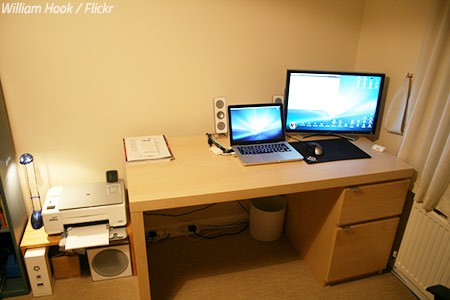
Moving a large desk to another home can be tricky.
Moving heavy furniture from one home to another is never an easy task. And that’s exactly why you have to be sure you’re doing the right thing when you make up your mind to transport a bulky furniture piece all the way to the new home.
Time and effort aside, moving furniture across country will also cost you a good deal of money too due to the large dimensions and considerable weight. However, you may own a few furniture items that are definitely worth moving to a new home despite all the hassle involved in the relocation process.
Like the lovely oak desk you’ve had since you can remember.
In fact, you may love your desk for a number of good reasons: material, design, functionality, aesthetic value, and last but surely not least – sentimental attachment. So, no matter how much it costs to move a desk across country, you’re definitely taking your favorite piece of furniture.
Read on to learn how to move a desk by yourself – that is, move a desk without hiring movers.
Double-check if moving your desk is the best option
Before you prepare your desk for moving, you must be 100% sure that that furniture item is worth the trouble of moving a large and heavy item between two homes, often hundreds or even thousands of miles across the country.
Take a long, hard look at that desk in order to decide what to do with it. When unsure, use these pointers to help you reach an informed decision which you won’t regret after the move.
-
Condition. What’s the current condition of the desk – is it well-preserved or is it already in a bad shape? If you’ve had it for many, many years, maybe it’s time to finally take it out of service. On the other hand, if it’s relatively new, then not taking it with you will probably be a mistake.
Also, factor in the money you may have to pay to have it restored after the move. -
Quality. Is the desk made of solid wood and manufactured by a reputable manufacturer? As a rule of thumb, if you paid good money to buy it in the first place, then the furniture piece must be of good quality. That’s not always the case but it’s a reference point that can influence your decision one way or another.
Ready-to-assemble desks, like IKEA desks, are not usually worth moving to a new home. -
Functionality. Is the desk truly functional? Will you continue to use it in the new place? It’d be such a waste of time and money if you did pack and move your desk only to never actually use it later for some reason or another.
And here’s the other big question: will the desk match the rest of the furniture in the destination home? And will it fit in there at all considering its detentions? - Aesthetic. Is your desk exquisitely beautiful? If you own an antique desk, then it may truly be a joy to look at. And of course, not taking such a pretty object with you is definitely out of the question.
- Sentimental value. If you happen to feel some sort of sentimental attachment to that lovely object of yours, then there’s no doubt that you should move it with you. But how do you go about packing and moving a desk safely? Read on to find out.
Should you move your furniture or buy new after the move?
How to pack a desk for moving
The exact desk packing method you use will depend primarily on the overall size and shape of the furniture item.
- Small to medium-size desk. In general, you’ll only need to protect the surface of the entire desk with appropriate padding materials – thick furniture blankets in most cases, secure the drawers, and you should be ready to move it.
- Large desk. Large desks should be partially disassembled before you can pack them safely for the road ahead. Big L-shaped desks, for example, will have to be disassembled into two individual parts to be easily and safely carried out of the home.
But before you can move the desk out of your place and load it into the moving vehicle, you’ll have to do whatever it takes to protect it so that it won’t get damaged during the haul.
Here’s how to pack a desk for moving in 5 simple steps:
Step 1. Prepare the packing supplies
First of all, you’ll need to get hold of the right packing materials in order to protect the large and heavy furniture piece.
Here’s what you’ll need to pack a desk for a move:
-

Some desks are more difficult to pack and move than others.
Blankets. It’s best to use specialized furniture blankets that are well-padded and provide excellent protection for the delicate surface of your desk. You can purchase such moving blankets from a local moving company or from a reputable home improvement store (The Home Depot, Lowe’s, etc.)
- Packing paper. You’ll use soft wrapping paper as the first layer of protection for delicate desk elements.
- Bubble wrap. You’ll use it to protect any fragile components of your living room desk or office desk, right over the packing paper.
- Stretch wrap. You’ll use it to secure the furniture blankets to the desk.
- Packing tape. Packing tape comes very handy, but you should be careful not to apply it directly over the desk surface for fear of damaging its delicate finish.
Step 2. Disassemble the desk, if necessary
The best way to move a large desk is to disassemble it first in order to reduce its overall weight and size. This way, not only will you make the furniture piece lighter to lift and carry safely, but you’ll also make it more compact so that it safely goes through the door, around tight corners, and along the hallways of your home.
First of all, remove all desk drawers and put them aside for now – you’ll deal with them in the next step. Then, detach any desk elements that can be safely removed – for example, removable trays, glass panels, and so on – those will be packed separately from the desk itself.
In the case of a large L-shaped desk (corner desk), use a suitable screwdriver to remove the fastening elements that connect the two components. In the end, you should have your desk separated into two halves – something that will make your packing and moving job way easier. Remember to keep all small parts such as metal planks, bolts, nuts, screws, washer, etc. into a sealable plastic bag for safekeeping.
Finally, if the desk has legs that can be removed safely (usually unscrewed), then do it to facilitate the desk moving task even more.
How to disassemble furniture when moving
Step 3. Pack whatever desk components you’ve removed
This step is about packing whatever parts you’ve removed from the main desk structure – drawers (see the next step), glass elements (mostly panels or desktops), and legs.
If you just detached any delicate components – like decorations, then wrap those in wrapping paper first, then use bubble wrap on top of it to form a protective bundle. Use tape to secure the wrapped-up desk elements, now ready to be loaded onto the moving truck.
Wrap any glass desk parts in protective furniture blankets – be very careful not to break them, or worse – to cut yourself on the glass.
What to do when furniture won’t go through the door
Step 4. Pack up the desk drawers

Emptying the desk drawers is the best option when it comes to safety.
If the desk drawer has a variety of small items inside that are not too heavy and not breakable (this is important!), then you have the option to just leave those items inside the drawer as it is as a super-quick packing technique. Just place some sheets of paper on top to act as padding and wrap the entire open part of the drawer in stretch wrap. Then, wrap the drawer itself in a blanket.
On the other hand, if the desk drawer has relatively heavy items inside – such as books, for example, it’s best that you take them out and pack them separately. Why? It’s simple – you don’t want to compromise safety by hauling a desk drawer full of heavy stuff inside it.
Step 5. Protect the desk against damage
Now that you’ve disassembled the desk partially and protected its separate parts, it’s time to wrap up the main desk frame to keep it intact throughout the move. Do that by placing furniture blankets over the entire length of the furniture piece and then securing those protective pads with tape.
Don’t leave any areas of the desk uncovered, and don’t use packing tape directly onto the desk surface as the glue residue can easily hard your lovely desk.
How to protect furniture when moving
How to move a desk without professional movers
Now comes the hardest part – to take the protected desk and its components out of the home and load them onto the moving truck you’ve rented for the purpose.
And here’s the trickiest part too – since you’ve made up your mind not to use furniture movers to move the desk for you, you’ll have to rely on at least three of your good friends to give you hand with the heavy furniture lifting job. You’re strongly recommended NOT to try and move a desk entirely on your own – moving furniture by yourself is too risky for one person only and can easily lead to either property damage or personal injuries, or both.
So, before you move on to the first step of moving a desk by yourself, you have to know that some of your pals are coming over to help you out in that difficult transitional period. But if your buddies bail out and leave you all on your own, then should do the right thing and contact the best furniture movers in tour town or city.
Step 1. Inspect the exit path
When moving a desk without movers, check carefully the way out of the home and look for any potential problematic spots on your way out. Remove any types of obstacles along the way to keep accidents away from your doorstep.
Also, check to see whether you’re expected to have any issues when moving the desk through doorways, corners, and hallways. In general, you shouldn’t have any problems simply because you’ve already disassembled the large furniture item as far as it will safely go. When in doubt, take out the measuring tape and do the math.
Step 2. Use sliders to save your back
Even when partially disassembled, the desk may still be too heavy to handle safely. One way to keep things running smoothly is to use furniture sliders to get the heavy desk away from a wall, or to slide it easily across the room with no damage whatsoever to the floor.
Furniture sliders (aka gliders) are small pieces made of either hard plastic or rubber (for carpets) or felt (for hardwood and tiled floors). Using furniture sliders to move a desk is really easy – just position a slider under each leg or side (in case you haven’t removed the desk legs).
And then, you just give the heavy desk a little push or pull and it should slide effortlessly across the room. Remember to use the right type of slider depending on the type of floor in the room.
Safety tips for moving furniture
Step 3. Have a helper on each desk corner

What’s the best way to move a large desk? Get helpers.
Ideally, you’ll have an amateur helper at each desk corner when moving a desk without professional movers. That way, you’ll be able to just collectively lift and carry the heavy desk over a doorstep or another expected or unexpected obstacle along the way.
In the case of a desk that’s rather heavy but NOT excessively heavy, you and the rest of your helpers should be able to get it out of your place without too much trouble. The furniture piece has already been padded well, so property damage is very unlikely… as long as you’ve got the necessary manpower.
In the case of a super-heavy desk, you can choose to either slide it safely until you reach the front door, or get it up on a furniture dolly to wheel it out even more safely. If you happen to be moving out of an apartment building, then you should definitely use the building elevator to get it down to the moving van.
How to move heavy furniture by yourself
Step 4. Load the desk into the moving truck
The moment you reach the moving vehicle outside, you should use its motorized loading ramp to get the desk safely up into the back of the van. If the rental truck only comes with a standard loading ramp, then you should use that one instead.
Secure the padded desk to the side of the truck using straps or rope so that the heavy furniture piece won’t move during transit.
Step 5. Know your limits when moving a desk
There are numerous dangers when moving heavy furniture by yourself – a large desk in this case. That’s why it’s important to understand the risks before you do something which you may regret later on.
The trick to moving a desk without damaging your favorite furniture item or getting injured in the process is to know your limits – what you can do and what you shouldn’t do.
For example, if you’re moving out of an apartment and there’s no working elevator in the building, then you shouldn’t move the desk downstairs even when you have helpers by your side – it’s just too risky. Do yourself a favor and get experienced furniture movers to do it for you.
Another scenario where you should call in the pros is when you’re moving an antique desk that’s very dear to you. Minimize the risk of something bad happening to that exquisite furniture item by first contacting top-rated furniture movers in your area, and then purchasing additional insurance for the object with great sentimental value.
The post How to Move a Desk Without Hiring Movers appeared first on The Moving Blog.







